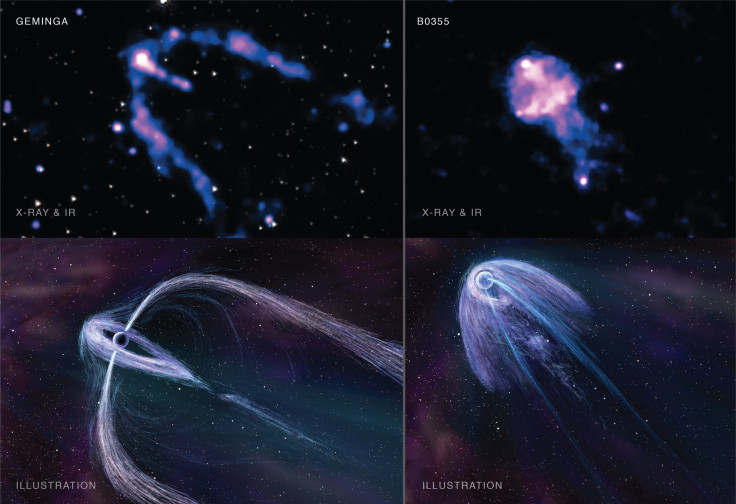Pulsar Emission Signatures: NASA Chandra X-Ray Observatory Images Reveal Crucial Clues About Variations

Pulsars — rapidly rotating neutron stars that produce lighthouse-like beams of radio or gamma ray emissions — were first discovered nearly 50 years ago. Although thousands of these fascinating celestial objects have since been spotted, several key questions — including those related to differences in emission signatures — are yet to be answered satisfactorily.
Now, in two separate studies, astronomers have used images of two pulsars recently taken by NASA’s Chandra X-ray observatory to suggest that differences in pulsar wind nebulae — clouds of high-energy particles associated with these neutron stars — could explain the presence or absence of radio and gamma-ray pulses.
“It's not fully understood why there are variations between different pulsars,” Bettina Posselt from Penn State University, the lead author of one of the studies describing the observations, said in statement released Tuesday. “One of the main ideas here is that pulse differences have a lot to do with geometry — and it also depends on how the pulsar's spin and magnetic axes are oriented with respect to line of sight whether you see certain pulsars or not, as well as how you see them.”
The two pulsars observed using the Chandra observatory are named Geminga and B0355+54, which are quite similar and rotate about five times per second. Both pulsars also contain a torus of emission spreading from their spin equator. Despite these similarities, however, Geminga was seen emitting gamma-ray pulses with no bright radio emission, while B0355+54 is one of the brightest radio pulsars known yet without a visible gamma ray signature.
According to the researchers, this difference in emission signatures can be explained in terms of the spin orientation of these pulsars, and also as a consequence of structural differences between their accompanying wind nebulae.
“Both pulsars have magnetic poles quite close to their spin poles, as is the case for the Earth’s magnetic field. These magnetic poles are the site of pulsar radio emission so astronomers expect the radio beams to point in a similar direction as the jets. By contrast the gamma-ray emission is mainly produced along the spin equator and so aligns with the torus,” NASA explained in a statement. “For Geminga, astronomers view the bright gamma-ray pulses along the edge of the torus, but the radio beams near the jets point off to the sides and remain unseen. For B0355+54, a jet points almost along our line of sight towards the pulsar. This means astronomers see the bright radio pulses, while the torus and its associated gamma-ray emission are directed in a perpendicular direction to our line of sight, missing the Earth.”
© Copyright IBTimes 2024. All rights reserved.












